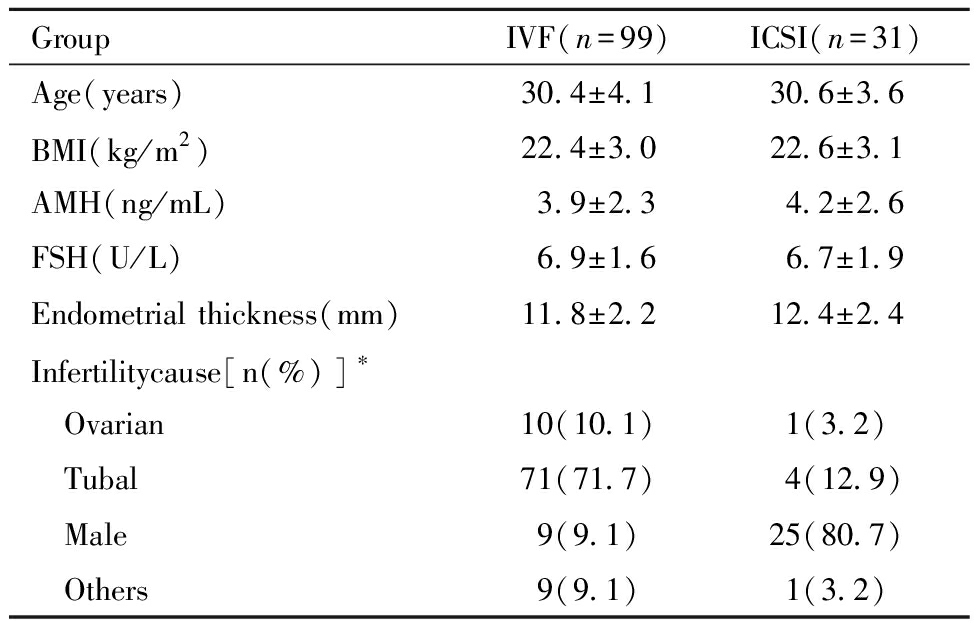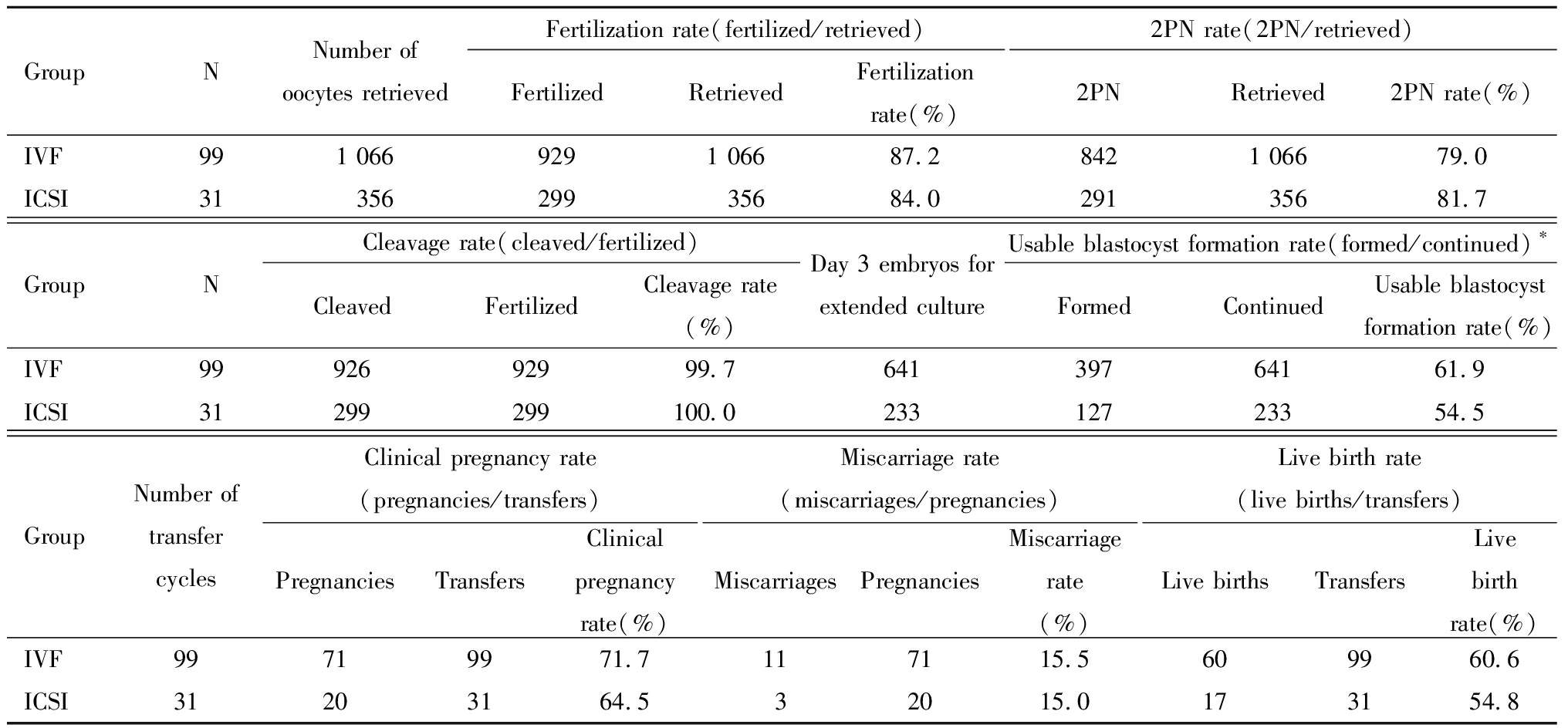常规体外受精(in vitro fertilization, IVF)和卵胞质内单精子注射(intracytoplasmic sperm injection, ICSI)两种不同授精方式,在胚胎发育速度以及发育潜能上会有所不同[1],是否会对妊娠结局产生影响,成为辅助生殖临床实践中持续关注的问题。为了更好地观察胚胎发育过程,近年来时差成像培养系统被广泛运用,其可以获得更为详细的胚胎发育的时间参数和卵裂模式,用来预测胚胎持续发育能力[2],其中早期异常卵裂已被证实会严重削弱胚胎的囊胚形成能力[3-4]。单囊胚移植[5]是将分裂胚培养至囊胚后进行移植,通过延长体外培养时间,可以筛选掉发育潜能较差的胚胎,从而获得更高的妊娠率,并降低多胎率而被广泛采用。本文借助时差成像培养系统,观察不同授精方式下胚胎各发育阶段的时间参数、卵裂模式是否存在差异,分析不同授精方式和不同卵裂模式下囊胚的形成能力,以及单囊胚移植的妊娠结局,从胚胎发育能力和囊胚种植结局两个方面分析授精方式对妊娠结局的影响。
资料与方法
一、一般资料
本研究收集2022年6月—2023年6月在南京鼓楼医院生殖医学科进入体外受精周期的患者,将胚胎在时差成像培养系统中培养至囊胚阶段,并行单囊胚移植的患者,按授精方式分为IVF组99例,ICSI组31例,进行回顾性分析。患者纳入标准:(1)常规IVF/ICSI周期;(2)女方年龄≤40 岁;(3)月经第3天卵泡刺激素(follicle stimulating hormone,FSH)≤12 U/mL;(4)长方案促排卵;(5)第一周期患者。患者排除标准:(1)完全或部分受精失败;(2)卵子异常;(3)PGT周期。130例单囊胚移植的患者共获得1 422枚胚胎,其中IVF组1 066枚,ICSI组356枚;将其中874枚2PN后培养至囊胚阶段的胚胎,按授精方式分为IVF组(n=641)和ICSI组(n=233),分析不同授精方式以及卵裂方式对囊胚形成的影响,并追踪研究130例单囊胚移植患者IVF组(n=99)和ICSI组(n=31)不同授精方式的妊娠结局。
二、方法
1.Time-lapse系统:采用EmbryoScope+(Vitrolife,瑞典)时差培养箱,培养箱内置高分辨率照相机(3像素/微米),拍照频率10 分钟/次。
2.配子采集与胚胎培养:采用常规促排卵方案[6],通过B超监测卵泡生长,等到主导卵泡直径达到18~20 mm后注射hCG,并于36 h后行阴道B超引导下卵泡穿刺取卵术。然后将获得的卵子按IVF或ICSI方案授精,之后将受精卵转移至含有G1-PLUS(Vitrolife,瑞典)培养液的时差成像培养皿(embryoslide+)中,置于EmbryoScope+(Vitrolife,瑞典)时差培养箱中培养至第3天,更换到含有G2-PLUS(Vitrolife,瑞典)培养液的时差成像培养皿(embryoslide+)中,继续培养至囊胚期。
3.囊胚分级:形成的囊胚根据ALPHA/ESHRE指南[7]对其质量进行分级,根据囊胚的扩张和孵出程度将其分为Ⅰ~Ⅵ级,根据内细胞团(inner cell mass,ICM)和滋养层(trophectoderm,TE)的质量分为A~C级。本文将囊胚评级为AA、AB、BA的定义为优质囊胚;评级为BB的定义为优良囊胚;评级为BC、CB的定义为低质量囊胚。
4.移植与妊娠结局判定:单囊胚移植周期中,在时差成像培养系统中培养到第5天,优先挑选高评级囊胚移植,移植后行常规黄体支持,2周后检测血hCG,当血hCG>5U/L,4~6周行B超检查,见孕囊和胎心者为临床妊娠。
5.记录时间参数:在时差成像培养条件下,观察植入前胚胎的发育过程,记录时差成像中胚胎发育的各项时间参数[8-9],如受精卵原核消失时间tPNf(time from insemination until pronuclei have faded)、2细胞形成时间t2(time from insemination to complete division to two cells)、5细胞形成时间t5(time from insemination to complete division to five cells)、8细胞形成时间t8(time from insemination to complete division to eight cells)、囊胚化开始时间tSB(time from insemination to start of blastulation)。
6.观测卵裂方式与卵裂同步性:分裂持续时间(如第二次有丝分裂的时间长度cc2=t3-t2)及分裂同步性(如第二次卵裂周期中卵裂球分裂的同步性s2=t4-t3)[9]。 “异常卵裂”是针对早期胚胎正常卵裂遵循的有丝分裂过程而言,正常情况下,受精卵经过第1次有丝分裂后,由1个细胞均等的分成2个细胞,经过第2次有丝分裂后,由2个细胞均等的分成4个细胞,其他卵裂情况均视为胚胎的早期异常卵裂[10]。
7.统计学处理:应用 SPSS 26.0 软件进行数据统计分析。计量资料应用t检验,以均数±标准差表示。计数资料应用χ2 检验,以率(%)表示,P<0.05 表示差异有统计学意义。
结 果
一、入组患者一般资料
符合纳入标准的患者共有130例,其中IVF组99例,ICSI组31例,患者一般资料见表1,两组之间除不孕因素外(P<0.01),其余一般资料差异没有统计学意义。
表1 患者一般资料
Table 1 Baseline characteristics of patients

GroupIVF(n=99)ICSI(n=31)Age(years)30.4±4.130.6±3.6BMI(kg/m2)22.4±3.022.6±3.1AMH(ng/mL)3.9±2.34.2±2.6FSH(U/L)6.9±1.66.7±1.9Endometrial thickness(mm)11.8±2.212.4±2.4Infertilitycause[n(%)]∗ Ovarian10(10.1)1(3.2) Tubal71(71.7)4(12.9) Male9(9.1)25(80.7) Others9(9.1)1(3.2)
*P<0.01
二、不同授精方式下受精与胚胎发育结局
ICSI组与IVF组相比,受精率和2PN受精率差异均无统计学意义,单囊胚移植后妊娠结局差异无统计学意义。IVF组相比ICSI组胚胎继续培养后有更高的囊胚形成率(P<0.05)。见表2。
表2 不同授精方式下受精与胚胎发育结局
Table 2 Fertilization and embryonic development outcomes by fertilization method

GroupNNumber of oocytes retrievedFertilization rate(fertilized/retrieved)FertilizedRetrievedFertilization rate(%)2PN rate(2PN/retrieved)2PNRetrieved2PN rate(%)IVF991 0669291 06687.28421 06679.0ICSI3135629935684.029135681.7GroupNCleavage rate(cleaved/fertilized)CleavedFertilizedCleavage rate(%)Day 3 embryos forextended cultureUsable blastocyst formation rate(formed/continued)∗FormedContinuedUsable blastocyst formation rate(%)IVF9992692999.764139764161.9ICSI31299299100.023312723354.5GroupNumber oftransfercyclesClinical pregnancy rate(pregnancies/transfers)PregnanciesTransfersClinical pregnancyrate(%)Miscarriage rate(miscarriages/pregnancies)MiscarriagesPregnanciesMiscarriage rate(%)Live birth rate(live births/transfers)Live birthsTransfersLive birthrate(%)IVF99719971.7117115.5609960.6ICSI31203164.532015.0173154.8
*P<0.05
三、不同授精方式下胚胎发育的时间参数和卵裂方式比较
ICSI组在tPNf、t2、t5上均显著早于IVF组(P<0.01),但t8、tSB组间均无差异(P>0.05),ICSI组在s2和(t8-t5)时间上均明显长于IVF组(P<0.01)。见表3。
表3 不同授精方式时间参数比较
Table 3 Time parameter comparison between insemination methods

GroupNumber of fertilized embryostPNF(h)∗t2(h)∗cc2(t3-t2)(h)s2(t4-t3)(h)∗t5(h)∗t8(h)t8-t5(h)∗tSB(h)IVF92923.4±4.025.9±4.19.5±4.21.5±2.747.1±7.054.7±7.76.2±7.093.4±7.1ICSI29921.9±3.224.4±3.39.1±5.92.3±3.945.1±7.854.9±8.68.5±8.293.3±6.7
*P<0.01
ICSI组早期异常卵裂比例显著高于IVF组(P<0.01),见表4。
表4 不同授精方式卵裂方式比较
Table 4 Cleavage pattern between insemination methods

GroupNumber of fertilized embryosNormal cleavage[n(%)]∗Abnormal cleavage[n(%)]∗IVF929562(60.5)367(39.5)ICSI299141(47.2)158(52.8)
*P<0.01
单独比较早期正常卵裂胚胎,两种授精方式时间参数并无区别(P>0.05),见表5。
表5 不同授精方式中正常卵裂胚胎时间参数比较
Table 5 Time parameters of normally cleaved embryos by fertilization method

GroupNumber of fertilized embryostPNF(h)t2(h)cc2(t3-t2)(h)s2(t4-t3)(h)t5(h)t8(h)t8-t5(h)tSB(h)IVF56221.2±2.424.5±2.711.0±1.10.6±0.749.6±5.458.0±6.58.6±5.593.4±6.3ICSI14121.3±2.524.0±2.611.0±1.00.6±0.849.1±5.359.0±6.79.1±6.093.4±5.7
综上可知,由于ICSI组较高的异常卵裂比例,导致了与IVF组相比时间参数上的差异,ICSI组早期胚胎发育速度自受精卵原核消失后逐渐变慢,且卵裂球裂解同步性差于IVF组。
四、不同授精方式胚胎的不同卵裂方式对囊胚形成的影响
IVF组有641枚胚胎培养至囊胚阶段,ICSI组有233枚胚胎培养至囊胚阶段,比较后发现,ICSI组胚胎卵裂方式异常比例明显高于IVF组(P<0.05),且整体囊胚形成率低于IVF组(P<0.05)。IVF组和ICSI组中异常卵裂胚胎囊胚形成率均明显低于同组中正常卵裂的胚胎(P<0.05),在卵裂方式相同的情况下,IVF组与ICSI组胚胎囊胚形成情况相比并无差别(P>0.05)。见表6。
表6 不同授精方式胚胎的不同卵裂方式对囊胚形成的影响[例(%)]
Table 6 Impact of cleavage patterns on blastocyst formation[n(%)]

GroupIVFTotalNormal cleavageAbnormal cleavageICSITotalNormal cleavageAbnormal cleavageEmbryo number 641(100)411(64.1)230(35.9)233(100)121(51.9)112(48.1)∗Blastocyst formation rate 397(61.9)327(79.6)70(30.4)#127(54.5)∗96(79.3)31(27.7)#
Compared to IVF, *P<0.05; compared to normal cleavage with the same group, #P<0.05
五、不同授精方式单囊胚移植后临床结局
不同授精方式各组之间内膜厚度、四级囊胚占比、D5囊胚占比及各等级囊胚占比差异均无统计学意义。IVF组和ICSI组相比,两组行单囊胚移植后,临床妊娠率、流产率及活产率差异均无统计学意义;两组正常卵裂单囊胚移植后,临床妊娠率、流产率及活产率差异均无统计学意义;两组异常卵裂单囊胚移植后,临床妊娠率、流产率及活产率差异均无统计学意义。IVF组中,正常卵裂与异常卵裂单囊胚移植临床妊娠率、流产率及活产率差异均无统计学意义。ICSI组中,正常卵裂与异常卵裂单囊胚移植临床妊娠率、流产率及活产率差异均无统计学意义。见表7。
表7 不同授精方式移植后临床结局
Table 7 Clinical outcomes after embryo transfer

GroupIVFTotalNormal cleavageAbnormal cleavageICSITotalNormal cleavageAbnormal cleavageTransfer cycles9991831283Endometrial thickness(mm)11.8±2.211.8±2.211.9±1.912.4±2.412.3±2.313.6±3.2Blastocyst grading[n(%)] High-quality blastocysts83(83.8)76(83.5)7(87.5)27(87.1)25(89.3)2(66.7) Good-quality blastocysts15(15.2)14(15.4)1(12.5)4(12.9)3(10.7)1(33.3) Low-quality blastocysts1(1.0)1(1.1)0000Clinical pregnancy rate[n(%)]71(71.7)65(71.4)6(75.0)20(64.5)18(64.3)2(66.7)Miscarriage rate[n(%)]11(15.5)10(15.4)1(16.7)3(15.0)3(16.7)0Live birth rate[n(%)]60(60.6)55(60.4)5(62.5)17(54.8)15(53.6)2(66.7)
讨 论
IVF或ICSI两种不同的授精方式,是否影响胚胎持续发育能力,一直是胚胎学家们关注的热点。Dang等[11]通过一项随机对照试验发现,相比IVF周期,ICSI可以减少受精失败,从而降低周期取消率,但并不会增加活产率,同时Beroukhim等[12]的研究指出ICSI周期往往有较低的囊胚形成率。本文研究结果显示ICSI与IVF周期在受精率、卵裂率上均无明显区别,但ICSI周期在囊胚形成率上要明显更低。
ICSI影响胚胎发育的原因,文献提示与ICSI操作相关。Berntsen等[13]的研究指出,ICSI注射时对纺锤体的可能损伤,会带来更高的早期异常卵裂比例,从而影响了囊胚形成率。Liebermann等[14]指出,早期胚胎的发育速度与卵裂的同步性与囊胚形成有关。本研究发现,ICSI相比IVF周期,早期卵裂中裂解同步性更差,胚胎发育速度逐渐变缓,早期异常卵裂比例明显更高。根据Somfai等[4]的研究,早期胚胎出现异常卵裂会严重影响胚胎的持续发育能力,降低囊胚形成率,因而ICSI周期囊胚形成率明显低于IVF周期。本研究进一步证实,早期异常卵裂会影响早期胚胎发育速度以及卵裂同步性,ICSI周期因更高的早期异常卵裂比例,导致了较低的囊胚形成率,说明授精方式主要通过影响早期卵裂模式进而影响早期胚胎发育速度以及卵裂同步性,影响整体囊胚的形成率。
对于卵裂方式正常的胚胎,无论是ICSI还是IVF周期,与异常卵裂胚胎相比,早期胚胎发育速度以及卵裂同步性均更好,囊胚形成率明显更高。但在时差成像培养系统下[15],能够发育至囊胚阶段的胚胎,无论授精方式与卵裂模式,均具有相似的良好的种植潜能。囊胚形成过程中,胚胎会进行自我修复[16],Lagalla等[17]报道过异常卵裂的卵裂球通常会在发育过程中碎片化或在胚胎致密化时不能正常融合而被排出,以保证囊胚染色体的整倍性。王江等[10]的研究同样指出异常卵裂胚胎形成的囊胚与正常卵裂来源的囊胚在染色体整倍性以及临床妊娠结局和流产率上均无显著性差异。囊胚移植后的种植结局,并不受胚胎来源的影响。由此而言,囊胚培养仍是一种实用的胚胎优选方法。
单囊胚移植结局虽然不受授精方式的影响,但ICSI周期整体囊胚形成能力低于IVF周期,说明了授精方式对于胚胎利用仍有影响。在日常临床工作中,应审慎选用授精方式,严格把关ICSI适应证,遵守ICSI操作规范[18],尽可能减少对卵母细胞损伤,同时推广单囊胚移植,实现对胚胎的优选,以提高妊娠率并减少多胎妊娠。
1 郑炜炜,谭玉梅,祝晓丽,等.不同精子来源及受精方式对剩余胚胎继续囊胚培养结局的影响.生殖与避孕,2016,36:845-851.
2 Kovacs P.Embryo selection:the role of time-lapse monitoring.Reprod Biol Endocrinol,2014,12:124.
3 王沛青,徐志鹏,史建彬,等.植入前胚胎异常分裂对胚胎持续发育能力的影响.中国生育健康杂志,2024,35:68-70,98.
4 Somfai T,Inaba Y,Aikawa Y,et al.Relationship between the length of cell cycles,cleavage pttern and dvelopmental cmpetence in bvine ebryos gnerated by in vitro fertilization or parthenogenesis.J Reprod Dev,2010,56: 200-207.
5 李丝雨,师娟子.单囊胚移植在人类辅助生殖技术的应用优势及存在问题.医学信息,2021,34:61-64.
6 Zhou J,Wang S,Wang B,et al.The value of HCG serum concentrations after trigger in predicting pregnancy and live birth rates in IVF-ICSI.Reprod Biomed Online,2015,30:667-673.
7 Alpha Scientists in Reproductive Medicine and ESHRE Special Interest Group of Embryology.The Istanbul consensus workshop on embryo assessment:proceedings of an expert meeting.Hum Reprod,2011,26:1270-1283.
8 陈志坚,汪彩珠.时差成像技术用于胚胎选择的研究进展.国际生殖健康/计划生育杂志,2022,41:139-142.
9 王世凯,薛林涛,何冰,等.胚胎动力学参数与胚胎发育潜能关系的初步研究.中国临床新医学,2016,9:763-766.
10 王江,熊顺,韩伟,等.早期异常卵裂不影响囊胚染色体整倍性.生殖医学杂志,2021,30:1146-1151.
11 Dang VQ,Vuong LN,Luu TM,et al.Intracytoplasmic sperm injection versus conventional in-vitro fertilisation in couples with infertility in whom the male partner has normal total sperm count and motility:an open-label,randomised controlled trial.Lancet,2021,397:1554-1563.
12 Beroukhim G,Seifer DB,Chaplia O,et al.ICSI is associated with lower blastulation rates compared to conventional IVF among couples with non-male factor infertility and low oocyte yield.Fertil Steril,2022,118:e143.
13 Berntsen S,Laivuori H,la Cour Freiesleben N,et al.A systematic review and meta-analysis on the association between ICSI and chromosome abnormalities.Hum Reprod Update,2021,27:801-847.
14 Liebermann J,Knopoff E,Matthews J,et al.Developmental potential of early-cleaved embryos associated with higher rates of blastocyst formation and utilization for cryopreservation.Fertil Steril,2005,84:S289.
15 高洋,刘军霞,朱家红,等.时差成像系统对囊胚培养及妊娠结局的影响.生殖医学杂志,2020,29:1198-1203.
16 Zhan Q,Ye Z,Clarke R,et al.Direct unequal cleavages:embryo developmental competence,genetic constitution and clinical outcome.PLoS One,2016,11:e0166398.
17 Lagalla C,Tarozzi N,Sciajno R,et al.Embryos with morphokinetic abnormalities may develop into euploid blastocysts.Reprod Biomed Online,2017,34:137-146.
18 中国医师协会生殖医学专业委员会.卵胞质内单精子注射(ICSI)技术中国专家共识(2023年).中华生殖与避孕杂志,2023,43:659-669.